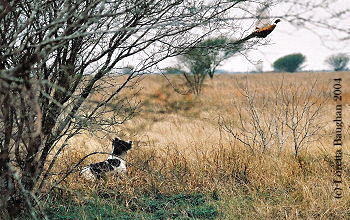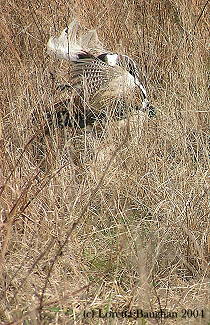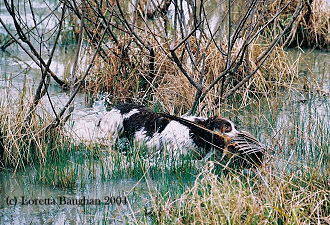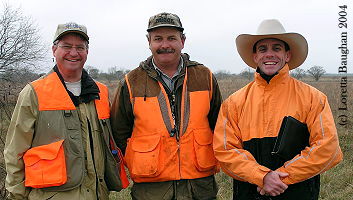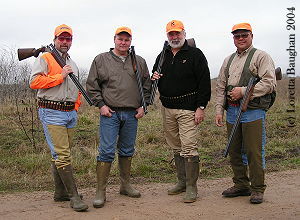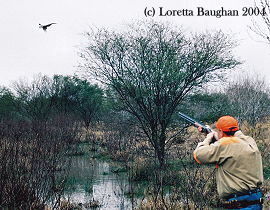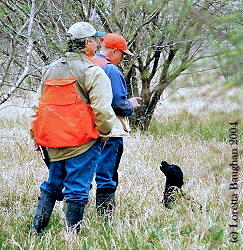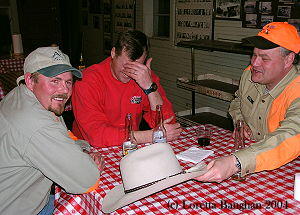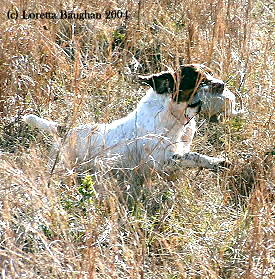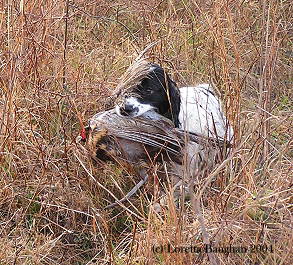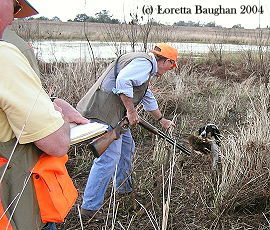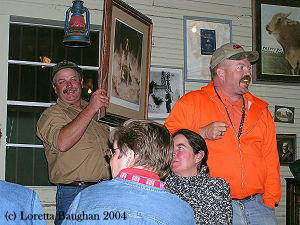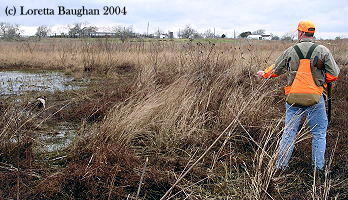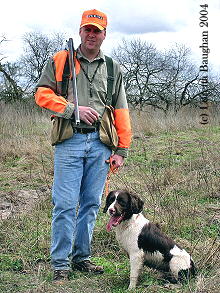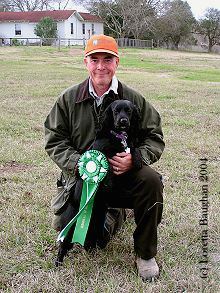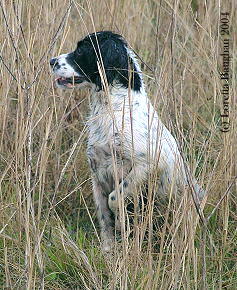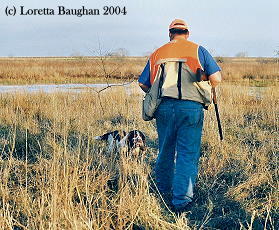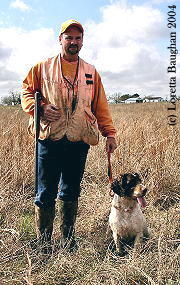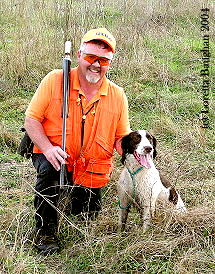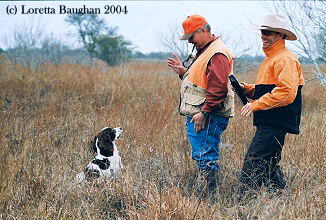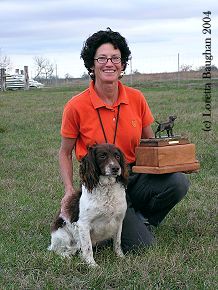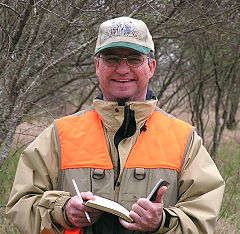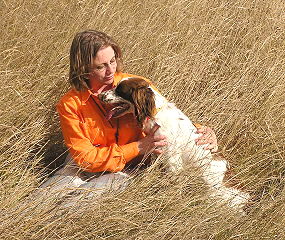or many reasons, it was a most welcome surprise to receive an invitation from my old friend, David Jones, to judge the fourth annual 2004 NESSSDC. Writing about some of my recollections from my time with the Saighton springers for the Spaniel Journal not only stirred up many great memories, but also awakened an interest in spaniels that had laid
dormant for some time. I hadn’t been to an American trial since the 1983 Nationals. A number of generations of springers had passed since then and many of the people running in trials have changed. Many more clubs have formed in the last 20 years and cocker trials have come into existence after a number of years absence in North America. I was most curious to renew my acquaintance with the spaniel scene in North America. I had visited the River Ranch, Tivoli,
Texas, the location of the championship headquarters in 1976 and knew it to be a fabulous place. It was sure to be a welcome temporary escape from the North Wales winter. Having heard reports of previous events and having known David Jones since I arrived in North Wales in 1975, I had little doubt this event would be one that I would remember for a long time. I looked forward to it with great anticipation.
As the date for the event approached, my anticipation grew. When I saw on the news European flights to the USA being seriously delayed and cancelled due to security concerns, I crossed my fingers that my travel arrangements would not be affected in such a way. I was most concerned when a few days before I was due to leave, the weather forecast was for artic conditions with a good likelihood of significant snow. In Great Britain, this means a few degrees below freezing
with the possibility of a couple of inches of snow. This is enough to bring all forms of transportation into complete chaos for several hours if not a day or two. When the time came to head for Texas, my anxieties were largely unfounded. Apart from a 45 minute delay in Manchester while a vehicle was found capable of pushing the plane from its berth through a scattering of snow that had fallen the night before and another 45 minute delay in Chicago for de-icing the
plane as Chicago was in the middle of a snow storm my travel to Austin, Texas, was straightforward and uneventful. I arrived in Austin about a half an hour before my co-judge, John Wright.
Although I had never met John, he was easy to spot wearing his signature cowboy hat that he had been wearing in every picture I had ever seen of him. I knew John has been one of the more successful trialers with his spaniels over the last several years and that he had a lot of experience hunting upland game with his spaniels. I was pleased to be judging with someone who had such a balanced experience with spaniels. The three-hour drive to the River Ranch gave us
a chance to get to know each other and talk about what we liked to see in a spaniel as a shooting dog. We talked about spaniels, hunting, close encounters with an angry moose, and other assorted topics.
We agreed besides being very proficient at the basics of finding, flushing and fetching, an ideal shooting dog should cover its ground thoroughly, in gun range, with minimal need for whistle or handling. We agreed that pure speed was not to be over emphasised for its own sake, although an ideal shooting dog did need to hunt at a sufficient pace taking into account the conditions. We also agreed dogs would be sent on all retrieves that were at all reasonable. Ideally,
retrieves should be marked well, but if the dog needed help and handled well this would be looked upon favourably. We both knew from our experiences hunting, there would be times a dog will need help to make a retrieve and a dog that can be easily handled to a retrieve is valued.
We arrived at David and Gail’s house about 10:00pm Thursday and were warmly welcomed by them and their two Irish Wolfhounds. A short distance from the house was what I can only describe as a “spaniel enthusiast camp.” A number of campers were parked and I could see spaniels being exercised in the floodlit field. As by then I had been up for the better part of 24 hours, David showed us to the judges house a short way down the ranch road. John and I got settled into our rooms and went to sleep.
Still on British time, I got up to walk over to David and Gail’s at 6:00am - tired of trying for some hours to get back to sleep and anxious to see some spaniels work. I knew trying to sleep any longer would be fruitless. In total darkness, I stumbled out the front door. I found my way to the road and headed in the direction of what I thought would lead to David’s. I hadn’t gone far when a pickup truck came up and stopped. The occupant asked if I was ok, and
did I need a flashlight? I said I was going over to David’s and asked whom I was speaking to. “I am Joe Keefe the ranch foreman,” was the reply. When I mentioned we had met about 28 years ago Joe said, “Are you John?” Joe invited me to ride with him as he went off to town to get a paper, but I carried on. When I got nearer to the lights I was walking toward I realised I was heading for the main ranch house (where I had last seen Joe 28 years ago) and not David and
Gail’s place. I couldn’t see any other lights, it was pitch dark and as a few drops of rain started to fall, I decided I had better wait for Joe’s return. Joe was soon back, and I was on my way to his house, next to the main house, for a cup of coffee.
I soon remembered one of the reasons I enjoyed my previous visit to Texas so much. The few Texan ranchers I have met have all been intriguing characters. Joe was much as I remembered him - although his skin had a more lived in and weather beaten look then when I last saw him. His look was typical of other ranchers I had met who worked out in the Texan sun a large part of their lives. Joe seemed to be a hard living, fun loving guy who loved doing what he did. The
coffee and my visit with Joe was an enjoyable way to start the day. I had no doubt then that I was back in Texas.
As dawn broke, Joe said he had to get to work, so he took me over to David’s. Things were starting to stir. David was out doing his morning chores and those trialers staying in campers on the ranch were coming out to exercise their dogs. There was a litter of puppies in a pen in front of David’s house. They could easily have come straight from Saighton’s kennels, 25 years ago. I was back in the spaniel world amongst spaniel enthusiasts.
As I looked over the running order, the only names I was familiar with from the past were David Jones and Jim Devoll. As various handlers introduced themselves to me, another familiar name came to light when Dean Reinke introduced himself. I met him while we both attended the 1983 Nationals, the last American trial I had attended until now. Dean said 1983 was the first National that he had attended. He was to be one of the guns for the first two series. From my
experience all those years ago with Dean, I figured we should have a few laughs during the next few days. I wasn’t wrong.
As the entry in 2004 was larger than in past years, it was decided the trial would start at the earlier time of 1 o’clock Friday afternoon instead of Saturday morning to ensure there was plenty of time to complete the final series. Later on Friday morning, David took John Wright and myself out to the McFadden ranch where the first two series were to be held. The first two series of the NESSSDC were to be run in the fashion of a normal spaniel trial - i.e. brace
work on pheasants with three assigned guns shooting. Each dog was given at least two contacts and at least one retrieve, in most cases. The judges would indicate when the dog could be sent for a retrieve and it was left to the handlers to handle their dogs at their discretion after demonstrating their dog’s ability to honor brace mate work.
It seemed there was suitable trial cover as far as the eye could see, but David found an ideal location. A shallow ditch ran through the field, which would be the centreline. Scrub brush and trees formed some of the mixed cover. Although it was not typical of cover used in most North American trials, John and I agreed with David that it was more like the type of place where you would find yourself hunting wild birds. David made sure everything was in place for the
start of the trial in the afternoon. As we headed for the McFadden Mercantile for lunch, a flock of Sandhill Cranes flying off were pointed out to me.
When I visit the USA now, I love finding places like the McFadden Mercantile. David said he was worried it wasn’t going to withstand the hurricane that hit the area some months back. I expect it had withstood a few hurricanes in its time and had withstood this most recent one unscathed. The McFadden Mercantile is one of those places that time seems to have passed by. Its beginning was when the world and life seemed much simpler. It still conveyed that feeling.
There were only a few small houses scattered around the vicinity and a railroad track nearby. I expect it was once a general store and café. Now it is just an eating place. It could have been used for a set of “The Walton’s” TV show. I had a double cheeseburger, which consisted of two of the thickest, tastiest burgers I have had in many years. A couple of locals - complete with cowboy hats, boots and spurs - were having lunch and for me, just added to the
atmosphere of the place. It was a great reminder that the USA didn’t only consist of shopping malls and fast food joints, which is easy for a visitor to think. Our hunger pangs well satisfied, it was time to see some spaniel work.
The weather, as the first of 34 starters ran, reminded me of many days I have experienced in North Wales. Overcast and comfortably cool, ideal for dog work. I knew it was much better than being in North Wales at the time, where cold gales were blowing with enough rain to cause extensive flooding, or the northern states where there were reports of ice storms, blizzards and temperatures many degrees below zero.
During the trial, conditions seemed to change several times a day. It ranged from cloudy and comfortably cool to sunny and warm with varying amounts of breeze. As the trial got underway, it was apparent that scenting was challenging without being impossible. Flushing a bird buried in a clump of cover, or tracking a moving bird took some work and effort on the dogs’ part. As is always the case, some found it more difficult than others.
As judges, John’s and my attitude for the first two series was to only eliminate dogs that eliminated themselves. Dogs that committed cardinal sins such as breaking, passing birds, failing a retrieve, etc... were dropped. Otherwise, the dogs were given the opportunity to be seen by both judges. As so much time was to be spent on each dog in the third series, a cut would have to be made after the first two series.
Watching spaniels work, hearing sandhill cranes calling in the distance along with the occasional flock of geese flying over Texan ranch country, I appreciated how lucky I was to be there. By late Friday afternoon, the first series was finished apart from a few dogs whose handlers couldn’t make it until Saturday. They would run first thing Saturday morning.
That evening, everyone returned to the McFadden Mercantile for good food, drink, conversation, and leg pulling. The evening enjoyment did not stop there. On return to the River Ranch headquarters each night, the happy campers would start a bonfire. Sitting on a camp chair sipping Jim Beam under the Texan night sky, the warmth of the fire keeping away the night chill, hearing the howl of coyotes, and enjoying the company of good spaniel people... I tried to remember when I last did anything like it.
We returned to the McFadden ranch at 8:30am on Saturday to finish the first and second series. In the first two series there was only one course. When the end of the course was reached, vehicles took us back to the beginning of the course. All dogs ran in the same direction on the same course. The breeze varied some as weather conditions changed, but was predominately a crossing wind. With a quick tailgate lunch, the judges had seen all the dogs through two series by mid-afternoon.
The final series was to be run at the River Ranch, so John and I retired to the judges' house on the ranch to sort out what dogs would be called back to the final series. There were fifteen dogs that performed well enough under both judges that we agreed to look at them together in the final series. Of the dogs that didn’t make it to the final series, the most common faults I saw were dogs that were inconsistent in their pattern, leaving ground unhunted and/or hunted
out of range. Certainly some dogs made it very difficult, if not impossible, for the guns to bring down birds at the range they were flushed.
As we still had a couple of hours of daylight, it was decided to start the final series. I said to John Wright that I was very interested in seeing how the final series would work out. John, having been to previous NESSSDC events, guaranteed I would enjoy it. On reflection, I can safely say this was an understatement.
The final series of the NESSSDC is what makes it an unique test for a spaniel. As is usual in North American trials, the dogs were run individually in the final series and observed by both judges. What is different is that the handler is the only one shooting over their dog. Besides this, the dogs were given 30 minutes to perform. Unlike traditional trials where the performance ends after a few contacts and retrieves are made, in this trial the series was 30 minutes
regardless of how many birds were worked in that time. This gave the dogs opportunity to work numerous birds with several retrieves. Not only were pheasants used, but also chukar partridge, quail, and pigeons were planted. To make things even more interesting, some of the plants were as doubles - so when a dog hit scent, no one knew what or how many birds would flush.
There were two courses set for the final series leading to the opposite side of a shallow pond. One course was into the wind and one was down wind. The cover was mixed grass and weeds with marsh grass around the pond area.
I don’t think I have ever seen a trial format that put dogs consistently into testing, interesting, and unusual situations. Flushes while out on retrieves were numerous. Some dogs had birds shot they flushed while sent on another retrieve. A dog could go into a clump of cover and catch a pickup, when the second bird flushed and was shot. Occasionally, when two birds flushed, two were shot (more commonly one was shot and one missed). In fact, just about anything
imaginable could and seemed to happen. Considering the trial was on planted game, it was a fabulous test of how dogs dealt with unexpected and unusual situations. A good working gundog on wild game needs to be able to take everything in its stride and sort out whatever situation that may happen. Every dog in the final series had opportunities to show how adept they were at this.
Four dogs had run their final series by the time darkness fell on Saturday. Already we had seen some excellent performances and we had another eleven dogs to see the following day.
That evening the trial banquet was held at the McFadden Mercantile. The NESSSDC is the brainchild of David Jones. As such, he has taken responsibility for organising this event with a lot of able assistance from Gail Brocklebank. At the banquet, David took the opportunity to thank the numerous people individually whose help and cooperation made it possible to put the event on - from bird planters and marshals to landowners and ranch foremen. Everyone showed their
genuine appreciation for those who made the event possible. From my vantage point, the trial progressed like clock work. Everyone and everything was always in the right place at the right time. As judges, we only had to concern ourselves with judging. The banquet ended with an auction - the highlight of which was auctioning a large, framed, limited edition print of a working springer.
The trial began again at 8:30am Sunday morning with the first of the remaining eleven dogs. We instructed the handlers to demonstrate the dogs steadiness and to send their dog on their own accord without needing judge’s permission. We expected handlers to deal with all situations as if they were on a normal shooting day.
I have never seen a trial where each dog and handler was applauded at the end of their run and each handler walked off the line with a beaming smile. Everyone got the opportunity to show how their dog could handle challenging situations that one would not often see in a traditional trial. Running for 30 minutes and working a number of birds (7-10 or even more) made it impossible to hide any faults a dog might have. I certainly found it a lot of fun to watch the dogs work under
these circumstances, as I believe everyone else did. Time and time again I thought to myself, “this will be interesting to see how the dog handles a particular situation.” It was late afternoon when all the finalists had been given the opportunity to perform. Overall, I was impressed with how the dogs did. It seemed every one of the fifteen finalists had their moment of glory where they handled a challenging situation beautifully.
After reviewing all the performances, we found there were seven dogs that stood out as exceptional shooting dogs. Although one judge or the other could criticize an incident or another with most of the dogs, these dogs consistently showed that they met our criteria of excellence. Any one of these seven dogs I would be more than happy to have as a gundog on a day’s shoot. We gave three certificates of merit. These three were certainly well deserving of recognition for their
performances. I found it difficult to separate them from the placing dogs.
The certificates of merit went to the following:
Jim Keller and Jake
Jake did his job very well. He is a big, strong, good going dog that handled easily, covered his ground well, and found his birds. Jim told me he hunts a lot of woodcock and ruffed grouse in Maine. Perhaps if there were trees for the birds to dodge through he could have given Jake a few more retrieves to show off Jake’s abilities better.
Buck Grabowski and Crash
I hoped I would get to see a cocker work on this trip. I have had limited experience of seeing cockers work in the UK, but have never seen a cocker work under American conditions and was most interested in seeing how they performed.
Crash was the only cocker that started the trial. I was really glad this team came. Crash’s merry cocker style and boundless energy and enthusiasm was a lot of fun to watch. If I had been told I could take any dog at
the trial home with me I would have seriously considered taking this talented, good-looking cocker. I’m sure Crash is a lot of fun to work as well as a pleasure to watch.
Gene Deveraux and Maddie
When Maddie started working, I couldn’t quite believe what I was seeing. During a break in the action, I went over to David Jones. Before I could say anything David said, “She reminds you of Spitfire, doesn’t she?" Saighton’s Spitfire was my companion and personal gundog for my entire time at Saighton kennels. Apart from being black and white rather than liver and white, I could not believe the similarity between Maddie and Spitfire. Not only did
she have similar markings, physique, and style, but also her temperament seemed similar. Every retrieve Maddie went on seemed to throw up one testing unusual circumstance or another. Nothing seemed to faze her as she handled everything thrown at her calmly. I couldn’t help but think, “That’s how Spitfire would have handled it.” Talking to Gene later about Maddie she remarkably even seemed to have some of the non-working mannerisms that Spitfire had. If Gene enjoys his
time with Maddie half as much as I enjoyed my time with Spitfire, he will be a lucky man.
Fourth place went to Tex handled by Marty Knibbs.
Marty showed himself to be the consummate professional both in handling his dogs and shooting. Tex’s run was capped off with a double retrieve of pigeons in the pond. One of the things that struck me about this series was how Tex suddenly seemed to go from trial dog mode to gun dog mode when Tex seemed to realise the series was not a two bird series. Once Tex made this realisation, he paced himself and quartered a perfect pattern without need for any handling.
Third place went to Bob Iversen’s Doogie handled by Mark Hairfield.
Mark and Doogie were not taking any prisoners in the final series. Doogie found the birds and Mark knocked them down.
John and I thought Doogie was going to run himself into the ground early on in his series, but miraculously Doogie seemed to get a second wind at the pond and finished strongly.
Second place went to Dan handled by Steve Beyer.
Dan was one of the older - if not the oldest dog in the trial. He handled easily and covered his ground well. To me, Dan showed the wisdom of his years. Time and again Dan showed intelligent use of his nose and the wind. Although Dan was not the flashiest dog in the trial, he was very effective and work oriented, in a mature and intelligent manner.
First place went to Jake handled by Phillip Somers.
Jake showed himself to be an excellent game finder. Jake was in a real groove for his final series. He ran wide and hard and covered his ground beautifully with little need of handling. This carried on even when the course was down wind. The handler had to do little more than walk behind Jake and shoot the birds when they got up. Jake did everything else in a non-slip manner that was most pleasing to watch.
Mhari Peshel was given the award for the best lady handler. Mhari was not in the final shake up in this year’s event; although I understand she often has been in past Championships. David decided to name the trophy for this award the Saighton’s Spitfire Memorial Trophy. Spitfire, to me, was the epitome of an ideal shooting dog. Both this event and Spitfire have given me unforgettable memories. To have Spitfire and this championship associated in this way was a great thrill for me.
Sunday night after the awards were given, anyone who wanted to go was invited to Joe Keefe’s for a Super Bowl party, followed by the nightly bonfire.
The following morning I watched a training session as a number of handlers started their dog’s preparation for the next trial. Although the field training seemed much as it always has been, some of the modern day “yard” work described to me by Marty Knibbs and Gene Deveraux was completely alien to anything I knew, but obviously very effective. In the afternoon, David treated John Wright and myself to an afternoon of quail shooting over his fine team of pointers. Although I
had shot many quail over my springers in Ohio, this was the first time I had shot quail over pointers in wide open country, a great way to cap off a great adventure.
The following morning I was on my way back to Austin with John Wright. I felt a tinge of sadness as I realised my Texan adventure was quickly turning into just a memory. I also felt lucky to be able to have such a great memory. As exciting as modern day spaniel trials are to watch, one does sometimes wonder if they really test the dogs thoroughly as practical shooting dogs. The NESSSDC, more so than any trial I have observed anywhere, is a tough and thorough test of a spaniel
as a practical shooting dog. Anyone who wants to test their dogs in such a way, have a lot of fun, and perhaps have a great adventure should try the NESSSDC.
National English Springer Spaniel Shooting Dog Championship Info
Official NESSSDC website provides event details and the photo album of the 2004 event.
To become a Sponsor of the 2005 NESSSDC, contact David Jones at
|
|


